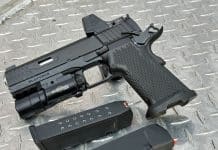Germany, a nation that definitely knows something about submarines, is about to deliver the first of at least three advanced submarines to Israel. The sub—known as the “Super Dolphin”—is a follow-on to the three Dolphin-class vessels (the Dolphin, Leviathan, and Tekuma) that Israel received from Germany. (Two were donated; the third Israel purchased.) The subs were commissioned in 1999 and 2000.
[dcs_chain_gallery number=”6″ gid=”15″ desc=”true”
name=”false” float=”right” tw=”36″ th=”36″ w=”300″
margin=”4px 0px 15px 15px”]
At 223 feet, the new sub—which will be christened the Tannin, or Crocodile—is 36 feet longer than the 187-foot size of the first three boats in the class. The additional hull allows for an air-independent propulsion (AIP) system, which will enable the Tannin and any follow-on boats (Israel has contracted for two with an option for a third) to remain submerged for much longer periods of time despite their non-nuclear propulsion.
All of the Dolphin-class boats have ten torpedo tubes, six 533mm-diameter tubes and four 650mm. The four larger tubes are the significant ones, since they enable the subs to fire surface-to-surface missiles (the Harpoon missile is the current choice) or launch swimmer delivery vehicles (SDVs) capable of delivering special operations forces to a hostile shore.
The most significant aspect of the 650mm tubes—one that is particularly significant given current events in the region—is that they presumably enable the Dolphin class to launch the Popeye Turbo cruise missile, according to an opinion expressed by the Federation of American Scientists. The U.S. Navy detected a test of the Popeye Turbo in the Indian Ocean in May 2000 that hit a target 1,500 km distant, so it would seem that opinion was well-informed. Moreover, the Tannin is being rumored from the start to have “second-strike nuclear weapons capability,” despite normal Israeli reticence about divulging details of such sensitive weapons systems.
The Popeye Turbo is believed—again, the Israelis don’t volunteer a lot of details—to be capable of carrying a 200-kg warhead containing 6kg of plutonium. The missile is certainly capable of reaching any target in Iran from the Gulf of Oman. While Israel’s submarines are officially based at Haifa in the Mediterranean, Israel does have an alternate base at Eilat on the Red Sea—providing access to the Indian Ocean and Arabian Sea without the need to transit the Suez Canal if it chose to shift one or more boats to that location.












